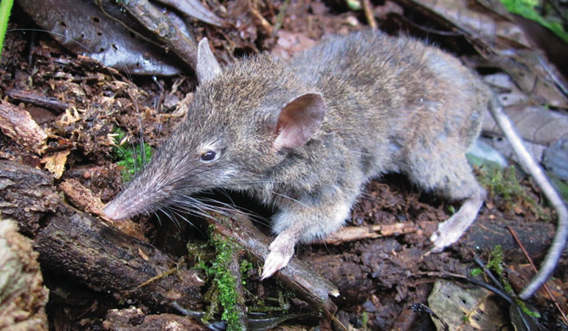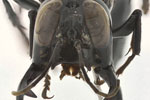
A rodent unlike any other: Paucidentomys vermidax. Photo from: Esselstyn et al.
The Indonesian island of Sulawesi is a workshop of bizarre evolutionary experiments. Think of the babirusa, pig-like species with tusks that puncture their snouts; or the maleo, a ground-bird that lays its eggs in geothermal heated sand; or the anoa, the world’s smallest wild cattle. Now the island, made up of four intersecting peninsulas, can add another bizarre creature to its menagerie of marvels: the Paucidentomys vermidax, a new species of rodent that is different from all others.
Unlike the over 2,000 known species of rodents, Paucidentomys vermidax lacks cheek teeth, which makes it impossible for the species to gnaw on its food. So, if the rodent is not gnawing on nuts and seeds what does it eat?
“Stomach contents from a single specimen suggest that the species consumes only earthworms,” the discoverers write in a new paper in Biology Letters. The scientists speculate that the species actually lost its gnawing incisors, which in most other rodents grow continuously, allowing it to “exploit resources that were not previously available,” i.e. earthworms or other soft-tissued prey. Sporting only two teeth, think of Paucidentomys vermidax as the geriatric of the rodent family.
“With the transition to soft-bodied prey, the mouth was relieved of the need to process food by chewing, and therefore was free to evolve according to the pressures of food acquisition,” the researchers write.
Although somewhat related to shrew-rats—which are rodents and not true shrews found on Sulawesi as well as Luzon Island in the Philippines—the researchers write that Paucidentomys vermidax goes beyond even its closest relatives since it “lacks molars and possesses bicuspid upper incisors, both of which are unique among the more than 2,200 rodent species.”
Discovered in montane forests on Sulawesi’s Mount Latimojong and Mount Gandangdewata, the researchers decided the new species was unique enough to warrant its own genus: Paucidentomys, which means ‘few-tooted mouse.’ While its species name, vermidax, translates to ‘worm-devourer’.
Despite its distinctiveness, the scientists think that Paucidentomys vermidax, or few-toothed worm eater, may face competition both from other shrew-rats and from proper shrews.
The researchers don’t address conservation issues related to Paucidentomys vermidax , however the island of Sulawesi has experienced vast deforestation and forest degradation in recent decades, resulting in many of its species becoming endangered. Since it’s found in high-altitude montane forest, Paucidentomys vermidax may be at least partially protected from conversion of forests into crops.

Image of Mount Gandangdewata. Image created using Google Earth.
CITATION: Jacob A. Esselstyn, Anang Setiawan Achmadi and Kevin C. Rowe. Evolutionary novelty in a rat with no molars. Biology Letters. August, 22nd 2012. doi: 10.1098/rsbl.2012.0574.
Related articles
New mammal discovered in Indonesia
(07/24/2012) Researchers have discovered a new species of rodent in Indonesia’s Mekongga Mountains, reports the Jakarta Post. The new rodent, Christine’s Margareta rat (Margaretamys christinae), is only the fourth in the genus Margaretamy, all of which are found on the island of Sulawesi.
Saving Indonesia’s monkey with a heart-shaped bottom

(06/05/2012) North Sulawesi is one of the world’s most beautiful places. Verdant forests and stunning coral reefs, combined with high levels of species endemism, make it a top biodiversity hotspot. But pressure on the region’s natural resources is mounting. Mining projects, conversion of forests for plantations, overfishing, and the expansion of a commercial bushmeat trade is endangering some of Sulawesi’s most charismatic animals, including the distinctive Sulawesi crested black macaque. Found only in North Sulawesi, the crested black macaque could be one of Indonesia’s most iconic conservation symbols, but relatively few people know of its existence. And the locals who do may be inclined to eat it as a delicacy.
Charts: deforestation in Indonesia and Malaysia, 2000-2010

(07/15/2012) Indonesia and Malaysia lost more than 11 million hectares (42,470 square miles) of forest between 2000 and 2010, according to a study published last year in the journal Global Change Biology. The area is roughly the size of Denmark or the state of Virginia. The bulk of forest loss occurred in lowland forests, which declined by 7.8 million hectares or 11 percent on 2000 cover. Peat swamp forests lost the highest percentage of cover, declining 19.7 percent. Lowland forests have historically been first targeted by loggers before being converted for agriculture. Peatlands are increasingly converted for industrial oil palm estates and pulp and paper plantations.
Meet the just discovered ‘Komodo dragon’ of wasps

(08/28/2011) A new species of warrior wasp has been discovered on the Indonesian island of Sulawesi that is so large and, frankly, terrifying-looking that it has been dubbed the ‘Komodo dragon’ of the wasp family. Bizarrely, the male of the species has jaws that outstretch its limbs. “I don’t know how it can walk,” said the wasp’s discoverer, entomologist Lynn Kimsey of the University of California, Davis and director of the Bohart Museum of Entomology, in a press release. “Its jaws are so large that they wrap up either side of the head when closed.”
Cute animal picture of the day: baby tarsier
(07/29/2011) The spectral tarsier of Sulawesi is one of the world’s smallest primates, weighing roughly the equivalent ten U.S. quarters when full-grown.
2-4 new shrew species discovered in Sulawesi
(06/28/2011) A research expedition has turned up two to four new species of shrew on the Indonesian island of Sulawesi, reports a conservation group working to protect their forest habitat.
Distressed Place and Faded Grace in North Sulawesi

(05/10/2011) The Nantu Wildlife Reserve is located in northern Sulawesi’s Minehasa Peninsula, in Gorontalo Province. Sulawesi is among the largest of Indonesia’s some seventeen thousand islands. Its shape is bizarre: a sinuous sprawling monkey, with lavish tail, poised to leap the straits of Makassar. Sulawesi lies to the north of Bali and Lombok and to the east of Borneo. Alfred Russell Wallace, the nineteenth century English explorer and natural scientist of broad expertise, spent a lot of time in Sulawesi’s northern peninsula, casting his curiosity and observation with such singular acuity that his mind apprehended “Darwin’s theory of evolution” independently from and possibly before Darwin. His work described the zone of transition between the Asian and Australian zoographic regions and was so accurate and thorough in its logic that today, some one-hundred and fifty years later, the zone is named Wallacea.